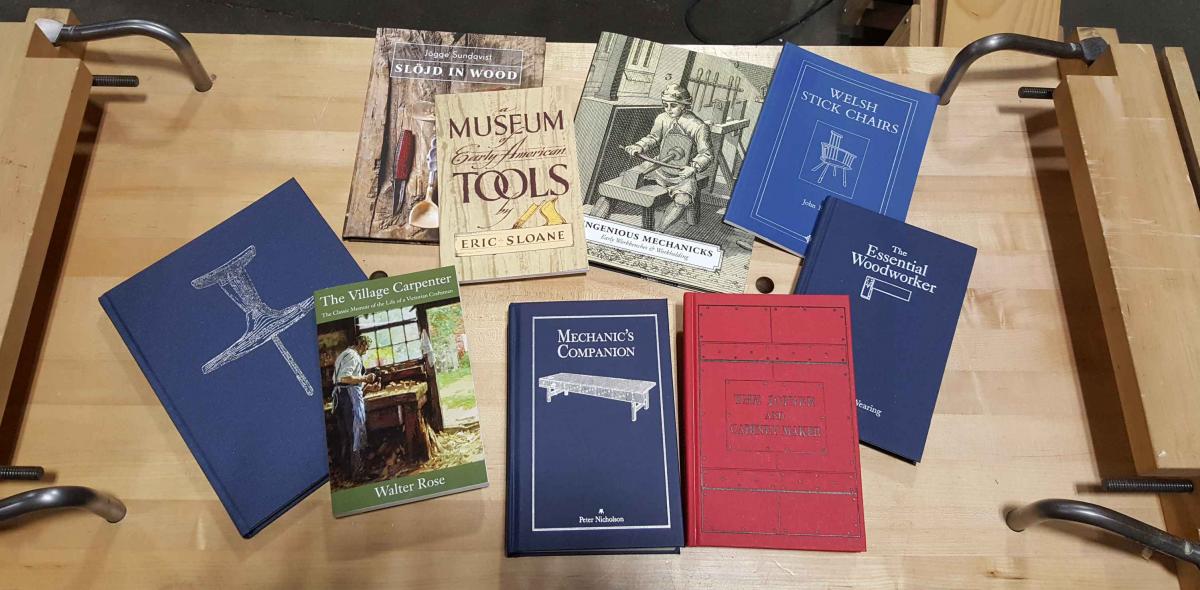| | 11/14/2018 | 
I read a lot and I firmly believe that no matter how indispensable a YouTube video, a blog, or a magazine article can be, the long form of writing - a book - can both entertain and educate the way no other media can. Here is a short list of books that we stock, old and new that I think are worth reading. Now actually I think all the books we stock are worth reading, but I particularly wanted to highlight some personal favorites. I'm including some of the many new books we stock along with some classics that really shaped my understanding of woodworking.
In no particular order:
The Mechanic's Companion by Peter Nicholson. This is a high quality reprint of the 1841 American edition of the book, which was originally printed in 1812. The Mechanic's Companion is one of those books you don't actually read as much dip into. It's structured as a dictionary, and it's an important book for anyone who has an interest in historical woodworking. What really turned me on is the inclusion of the 1830 building code of New York City. This is so interesting to me because it's the first gasp of zoning and regulation in New York. We have to comply with Fire Department regulations for our aerosols and flammable storage regulations (including passing the Certificate of Fitness test) so the rise of safety regulations especially caught my eye. Apparently in 1830 the regulations were pretty similar, though they weren't about spray lacquer - they concerned whale oil and gunpowder. The book also covers the tools and usage for different trades. But there is so much crammed into the book, you can always learn something new. For me, the woodworking tool material wasn't unfamiliar but the section on plastering was totally amazing.
"The Joiner and Cabinet Maker" is approaching a decade since we put it back in print. I still find it as exciting as ever to go through. For anyone interested in working unplugged, the first two projects are a great first set of challenges. If you can complete the third project - a dresser - you can confidently say that you really know what you are doing. Back then I thought the book was the best education for hand tool usage out there, and today I would double down and also say it provides an anchor for other hand tool instruction you might (and should) get elsewhere. It's also a good read, which is why I think you can learn from it pretty easily.
Robert Wearing's - "The Essential Woodworker" is the single best book on useful advice on woodworking every written. Short and sweet, it's a great practical book no matter what equipment you use - hand or electric. I can't imaging not having a copy.
Lost Art Press just reprinted "Welsh Stick Chairs" by John Brown and issued an English-language version of Slöjd In Wood by Jögge Sundqvist. Both of these books are standards in their field and if there is any interest in chairs or Sloyd projects these are obvious choices. I also want to recommend "Woodworking in Estonia" which is another standard text for greenwood woodworking - a bit more hardcore and less accessible than the other two, but also very worthwhile.
If you are looking for a great gift set both Roubo books, The volume on cabinetmaking and the volume on marquetry are awesome for woodworkers with experience who are doing traditional work, and the entire series of Charles Hayward books are awesome for everyone - especially a newbie. (Hayward is hands down the best writer and illustrator of woodworking books ever.)
"Ingenious Mechanicks: Early Workbenches & Workholding" by Christopher Schwarz is a historic look at useful clamping accessories for your workbench. I found it very informative and helpful when we were developing our Planing Stops.
If you just want a good read - "The Village Carpenter" by Walter Rose has been a favorite of mine for years.
Hardcore carvers might like "Manual of Traditional Wood Carving" by Paul Hasluck. I'm actually in the middle of the chip carving section. I took Daniel Clay's course in September and Hasluck has an article on chip carving explaining the English method of doing it. I have also been poring over the book's decorative designs for furniture as part of my research for my blogs on "The Future of Furniture." The text is dense but chock full of useful stuff.
For younger people who have an interest in early crafts and tools, Eric Sloane's "A Museum of Early American Tools" had a huge impression on me when I was a kid. Still does.
P.S. Next week I will return to "The Future of Furniture" with Part 3: Tools!
PPS Yes, this title was inspired by the recurring sketch [could link: https://snltranscripts.jt.org/78/78dbooks.phtml] on Saturday Night Live with the original cast.
| Join the conversation | |
| The opinions expressed in this blog are those of the blog's author and guests and in no way reflect the views of Tools for Working Wood. |
|
 Joel's Blog
Joel's Blog Built-It Blog
Built-It Blog Video Roundup
Video Roundup Classes & Events
Classes & Events Work Magazine
Work Magazine



I purchased The Joiner and Cabinet Maker from you when I visited. I've read it, recommended it to others and just had a copy ordered for our library system. It's a wonderful book on so many levels. Thanks to you and Chris Schwarz for making it available.
Regards,
Eric Weissman
Bainbridge Island, Washington
Thanks for the heads-up on the books you offer. I'm a white belt in woodworking and they sound terrific. Question - How do I get to your website from your blog? Sorry but I'm not at all tech savvy.
Keep smiling,
Dan